
The Amish have long been known for their commitment to simple living and self-sufficiency, largely steering clear of contemporary conveniences like electricity and automobiles. Yet, as concerns about climate change and energy sustainability grow, even the Amish community has found ways to adapt while maintaining their values. Without compromising their traditional lifestyle, they have quietly embraced alternative energy solutions that not only align with their beliefs but also contribute to a more sustainable future.
Key Takeaways
- The Amish community’s adoption of alternative energy demonstrates their commitment to sustainable living and environmental stewardship.
- Their reliance on solar power, Amish windmills, water wheels, generators, and bioenergy showcases their ability to harmonize traditional values with modern solutions.
- The Amish prioritize simplicity, community, and self-reliance in their energy practices, offering a unique perspective on sustainable living.
From solar power to Amish windmill, they are finding innovative ways to power their homes, farms, and businesses—all while remaining true to their principles. This article explores the intersection of Amish tradition and alternative energy.
Historical Perspective: The Amish Approach to Energy
The Amish community’s approach to energy is based on their traditional values. They originally resisted conventional electricity to protect their identity and avoid modern influences. However, they’re not against progress; their choices reflect a balance between simplicity and independence. Their use of alternative energy supports their self-sufficient way of life.
Recently, more Amish communities have started adopting solar power. James Mast, founder of ARK Battery, explained that advances in technology now make it possible to power larger operations, like farms and workshops. This trend is expected to grow, reinforcing the Amish commitment to sustainability.
Here’s a simple table comparing traditional energy methods with the Amish approach to energy use:

Key Types of Amish Alternative Energy
While embracing a simpler lifestyle, the Amish have ingeniously harnessed various forms of alternative energy to power their homes, farms, and businesses.
Amish Windmill
Windmills, a traditional source of power, remain a common sight in Amish communities. Amish windmills harness the power of the wind to pump water, grind grain, and even generate electricity. Although less prevalent than solar power, windmills offer a reliable and sustainable energy solution, particularly in areas with consistent wind patterns. Windmills have been used by the Amish for centuries, reflecting their deep connection to traditional technologies.

Solar Power
The most prominent form of alternative energy adopted by the Amish is solar power. Photovoltaic panels, often discreetly installed on rooftops or barns, convert sunlight into electricity, providing a clean and renewable source of power. This technology has gained significant traction in recent years, enabling the Amish to operate appliances, lights, and even power tools without relying on the grid. According to The Times, approximately 50% of Amish households in Pennsylvania have installed solar panels.

Generators
While striving for self-sufficiency, the Amish also utilize generators for backup power or specific tasks requiring higher energy demands. These generators, typically powered by diesel or gasoline, provide a reliable source of electricity when other renewable sources are unavailable or insufficient.
Water Wheels
In areas with access to flowing water, water wheels offer another sustainable energy option for the Amish. These structures harness the kinetic energy of water to power mills, sawmills, and other machinery. Water wheels represent a time-tested technology that aligns with the Amish value of resourcefulness.
Biodigesters & Biofuels
Some Amish communities have embraced biodigesters, which convert organic waste into biogas, a renewable source of energy for heating and cooking. Additionally, the use of biofuels, derived from plant or animal matter, is gaining popularity as a cleaner alternative to fossil fuels for powering vehicles and machinery.
Environmental Impact of Amish Alternative Energy Use
The Amish community’s embrace of alternative energy has a profound and positive impact on the environment. Recent research by Dr. Marilyn Loveless has highlighted the significant environmental benefits of the Amish lifestyle. In a study comparing the carbon footprint of Amish residents in Holmes County, Ohio, to their “English” neighbors, she found that the Amish’s preference for horse-drawn buggies over internal combustion engines results in a dramatically lower carbon footprint in terms of transportation. In fact, the Amish produce approximately three times less carbon emissions from transportation compared to their English counterparts.
Here are additional insights from the same study:

Find quality, eco-friendly pieces on the Amish Furniture Factory page, crafted by communities embracing alternative energy solutions.
Conclusion
The Amish community demonstrates their ingenuity, resourcefulness, and unwavering commitment to sustainable living by embracing alternative energy. Although people often perceive them as traditionalists resistant to change, the Amish have quietly pioneered renewable energy, proving that they can harmonize traditional values with environmental responsibility. They show a deep respect for the environment and a desire to create a self-sufficient lifestyle that minimizes their impact on the planet through their use of solar power, windmills, water wheels, and bioenergy.
FAQs
How do the Amish generate electricity without using the public grid?
The Amish primarily generate electricity through solar panels, windmills, and generators. Solar panels convert sunlight into electricity, windmills harness the power of the wind, and generators, often used as backup power, run on diesel or alternative fuels.
What type of alternative energy is most commonly used by the Amish?
Solar power is the most commonly used form of alternative energy in Amish communities.
How do Amish windmills differ from modern wind turbines?
Amish windmills are typically smaller and simpler in design compared to modern wind turbines. They often feature wooden blades and are primarily used for mechanical tasks like pumping water or grinding grain.
What are the traditional uses of Amish windmills?
The Amish have traditionally used windmills for a variety of tasks, including pumping water, grinding grain, powering sawmills, and generating electricity for limited use.

What a wonderful story it’s not too late to diminish the amount of electricity utilized As laborsaving devices. To make work easier is to make it less healthy. If you employ the Extra electricity to mine Bitcoin You’ll be converting the electricity and power into value which is called proof of work. In each case you Are defying gravity one for health and one for value Julie away for the Meek to inherit the Earth. Etc. etc.
I am not much of a joiner! My ideas are my own however you’re more than welcome to Embrace an idea. If you’re artistic or creative at all you’ll understand what I’m going to say Picasso said that good artists borrow great artist Steel. Ps Don’t just borrow it steal it please. Together we can change the world!